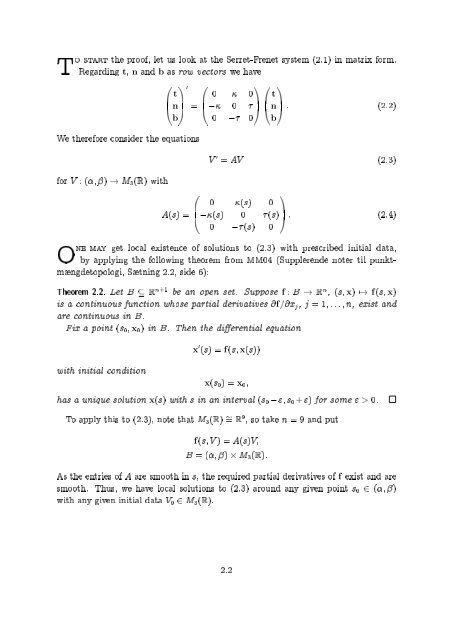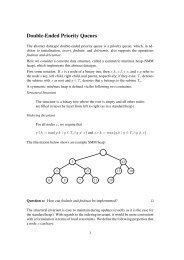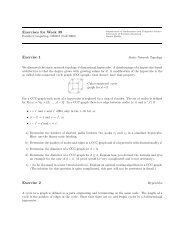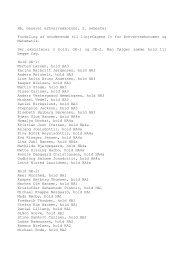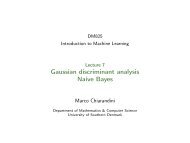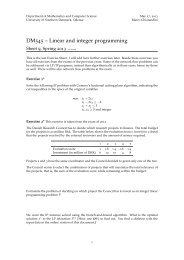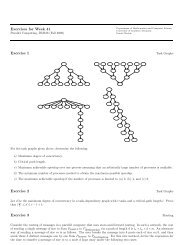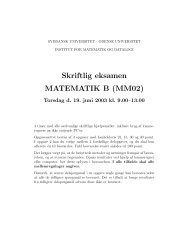2. On the Fundamental Theorem for Curves in Space
2. On the Fundamental Theorem for Curves in Space
2. On the Fundamental Theorem for Curves in Space
You also want an ePaper? Increase the reach of your titles
YUMPU automatically turns print PDFs into web optimized ePapers that Google loves.
To start <strong>the</strong> proof, let us look at <strong>the</strong> Serret-Frenet system (<strong>2.</strong>1) <strong>in</strong> matrix <strong>for</strong>m.<br />
Regard<strong>in</strong>g t, n and b<br />
0<br />
as row<br />
1<br />
vectors<br />
0<br />
we have<br />
1 1<br />
B@ t n<br />
b<br />
CA0<br />
We <strong>the</strong>re<strong>for</strong>e consider <strong>the</strong> equations<br />
<strong>for</strong> V : (; ) ! M 3 (R) with<br />
A(s) =<br />
=<br />
B@ 0 CA 0 B@ 0 t n<br />
0 <br />
0 0<br />
b<br />
CA : (<strong>2.</strong>2)<br />
V 0 = AV (<strong>2.</strong>3)<br />
0<br />
B@ 0 (s) 0<br />
(s) 0 (s)<br />
0 (s) 0<br />
1<br />
CA : (<strong>2.</strong>4)<br />
<strong>On</strong>e may get local existence of solutions to (<strong>2.</strong>3) with prescribed <strong>in</strong>itial data,<br />
by apply<strong>in</strong>g <strong>the</strong> follow<strong>in</strong>g <strong>the</strong>orem from MM04 (Supplerende noter til punktmængdetopologi,<br />
Sætn<strong>in</strong>g <strong>2.</strong>2, side 6):<br />
<strong>Theorem</strong> <strong>2.</strong><strong>2.</strong> Let B R n+1 be an open set. Suppose f : B ! R n , (s; x) 7! f (s; x)<br />
is a cont<strong>in</strong>uous function whose partial derivatives @f=@x j , j = 1; : : : ; n, exist and<br />
are cont<strong>in</strong>uous <strong>in</strong> B.<br />
Fix a po<strong>in</strong>t (s 0 ; x 0 ) <strong>in</strong> B. Then <strong>the</strong> dierential equation<br />
x 0 (s) = f (s; x(s))<br />
with <strong>in</strong>itial condition<br />
x(s 0 ) = x 0 ;<br />
has a unique solution x(s) with s <strong>in</strong> an <strong>in</strong>terval (s 0 "; s 0 + ") <strong>for</strong> some " > 0.<br />
To apply this to (<strong>2.</strong>3), note that M 3 (R) = R 9 , so take n = 9 and put<br />
f (s; V ) = A(s)V;<br />
B = (; ) ¢ M 3 (R):<br />
As <strong>the</strong> entries of A are smooth <strong>in</strong> s, <strong>the</strong> required partial derivatives of f exist and are<br />
smooth. Thus, we have local solutions to (<strong>2.</strong>3) around any given po<strong>in</strong>t s 0 2 (; )<br />
with any given <strong>in</strong>itial data V 0 2 M 3 (R).<br />
<strong>2.</strong>2


